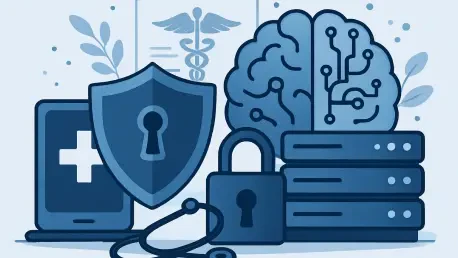In an age where artificial intelligence is reshaping the healthcare landscape with unprecedented speed, the protection of sensitive patient data has emerged as a paramount concern for industry leaders and policymakers alike, especially as cybercriminals increasingly target healthcare systems. Drawn by the vast troves of personal and medical information that fuel AI-driven innovations like predictive diagnostics and personalized care, these attackers pose a significant threat. However, as these technologies advance, so too do the risks, with larger datasets and automated processes becoming prime targets for sophisticated attacks. At the same time, regulatory frameworks are tightening, demanding greater accountability from organizations to safeguard this critical information. The convergence of technological progress and escalating threats creates a complex challenge, requiring a strategic balance between leveraging AI’s potential and ensuring robust cybersecurity. This exploration delves into the evolving dynamics of data protection, offering practical insights for healthcare entities to build resilience amidst rapid change and mounting pressures.
Evolving Regulations: A Call for Stronger Defenses
The regulatory landscape governing healthcare data security is undergoing a significant transformation, driven by the urgent need to counter escalating cyber threats in an AI-dominated era. New policies, such as the recently introduced Healthcare Cybersecurity Act and updates to the HIPAA Security Rule, are setting stringent standards for organizations. These mandates emphasize comprehensive risk assessments, the adoption of multifactor authentication, and robust data encryption practices. Smaller and rural healthcare facilities, often constrained by limited resources, face particular challenges in meeting these requirements, yet they stand to benefit from enhanced real-time threat-sharing mechanisms designed to bolster collective defenses. Compliance is no longer just a legal obligation but a critical component of maintaining trust and operational integrity in a sector under constant siege by digital adversaries.
Beyond domestic regulations, the global dimension of data protection is gaining prominence as national security concerns intersect with healthcare cybersecurity. Legislation aimed at preventing data transfers to adversarial nations reflects a growing recognition of health information as a strategic asset. For healthcare leaders, navigating this intricate web of rules involves more than just implementing technical safeguards; it requires a deep understanding of the geopolitical stakes at play. Aligning internal policies with these broader objectives ensures not only compliance but also positions organizations as responsible stewards of sensitive data in a world where breaches can have far-reaching consequences. Staying ahead of these regulatory shifts is essential for mitigating risks and fostering a secure environment for innovation.
AI’s Dual Role: Opportunity and Vulnerability
Artificial intelligence holds transformative potential for healthcare, offering tools like automated incident response systems that can detect and neutralize cyber threats far more rapidly than manual interventions. By analyzing patterns in vast datasets, AI enables proactive identification of anomalies, potentially preventing breaches before they escalate. This capability is particularly valuable in an industry where downtime or data loss can directly impact patient outcomes. However, harnessing these benefits demands careful integration into existing security frameworks to ensure that AI enhances rather than undermines protective measures. As healthcare systems increasingly rely on such technologies, the focus must remain on maximizing their defensive strengths while maintaining rigorous oversight to avoid unforeseen pitfalls.
Yet, the adoption of AI also introduces significant vulnerabilities that cannot be ignored in the quest for efficiency. The massive datasets required to train models, such as large language models used in clinical applications, make healthcare organizations lucrative targets for cybercriminals seeking to exploit valuable information. Additionally, the risk of automation bias—where staff overly depend on AI outputs without critical evaluation—creates openings for malicious actors to manipulate systems undetected. Addressing these challenges requires strict governance, including securing data used in AI development and conducting regular audits of automated processes. By balancing innovation with caution, healthcare entities can transform AI from a potential liability into a cornerstone of a fortified cybersecurity strategy.
Addressing Systemic Weaknesses in Healthcare Security
Despite the promise of cutting-edge technologies, many healthcare organizations remain burdened by outdated legacy systems that lack modern security features and are prone to exploitation by cyber attackers. These aging infrastructures often cannot support the latest protective measures, leaving critical data exposed to risks. Compounding this issue is the proliferation of connected devices, from hospital equipment to personal wearables, which exponentially increases the attack surface. Each new endpoint represents a potential entry point for hackers, making comprehensive network monitoring and device management non-negotiable. Tackling these systemic flaws demands substantial investment in modernization, prioritizing the replacement of obsolete systems with solutions designed for today’s threat environment.
Human factors also play a pivotal role in the security equation, often representing the weakest link in an organization’s defenses. Insufficient training and a shortage of skilled cybersecurity personnel leave staff ill-equipped to recognize and respond to sophisticated threats like phishing attacks. Building a culture of security awareness through consistent education programs, simulated attack exercises, and clear protocols can significantly reduce the likelihood of human error leading to breaches. Empowering employees to act as the first line of defense transforms a potential vulnerability into a strength, reinforcing the overall resilience of healthcare systems. Addressing both technological and human elements in tandem creates a more holistic approach to safeguarding sensitive information against persistent dangers.
Building Resilience: Strategies for the Future
Looking back, the journey to secure healthcare data amidst the rise of AI revealed a landscape fraught with both opportunity and peril, where every advancement seemed to carry a corresponding risk. Reflecting on past efforts, it became evident that fragmented approaches often fell short against the sophistication of modern cyber threats. Organizations that hesitated to modernize infrastructure or invest in workforce training frequently paid a steep price in compromised data and eroded trust. The lessons learned underscored the necessity of proactive adaptation over reactive measures, highlighting that resilience was not a destination but an ongoing commitment shaped by each challenge encountered.
Moving forward, healthcare entities must prioritize a unified strategy that integrates robust data governance with the responsible use of AI, ensuring that innovation does not outpace security. Implementing frameworks like zero-trust architecture and network segmentation can provide critical layers of defense, while regular risk analyses and tested incident response plans prepare systems for inevitable attacks. Collaboration across internal teams and with external technology partners offers a pathway to staying ahead of evolving threats and regulatory demands. By fostering a culture of continuous improvement and vigilance, the industry can transform past vulnerabilities into stepping stones for a more secure future, protecting patient data as a cornerstone of trust and care.









